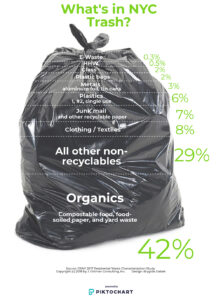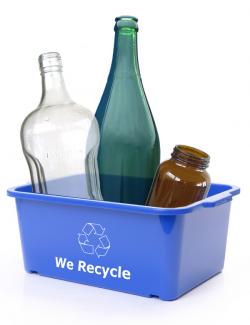First the bad news:
NYC’s recently released 2017 Waste Characterization Study which measures how much we throw out and how much of that we recycle, indicates that recycling rates are still dismally low, and we still throw away more than we recycle. Meanwhile, costs to export our waste (NYC has no landfill or incinerators) are escalating, and now stand at $400MM per year.
Now, the good news:
77% of NYC’s residential waste is recyclable, and DSNY programs are in place for residents to conveniently drop-off many recyclables in neighborhoods, and even within apartment buildings. These days, the average NYC household throws away less because of shifts in consumption, like using online news sources instead of newspapers, but still tosses 1990 lbs per year — nearly a ton of trash.

Worried that NYC will drown in trash? Want to make a difference? As depicted on the graphic, New Yorkers can reduce up to 70% of their trash just by recycling more. Here’s how.
Compost the Scraps – 42%
Besides eating all our veggies, the best thing New Yorkers can do to cut down on food scraps, food-soiled paper, and yard and plant trimmings is to drop them off at local greenmarkets, or take advantage of DSNY’s free Organics Collection service, available in many neighborhoods and for buildings with 10+ units. While you’re at it, take the ‘sniff test’ and stop throwing away perfectly edible food before its time.

boxes
Recycle clothing – 8%
Why trash perfectly usable clothing? Locate a thrift or consignment shop near you at DonateNYC. Not so reusable? At least give it a shot at getting recycled into insulation and other useful material. Enroll your building in DSNY’s convenient ReFashionNYC and arrange for curbside collection of all clothing, shoes and textiles. For fun, learn how to ‘visibly mend’ clothes as a new creative outlet — and extend your wardrobe indefinitely.
Recycle junk mail – 7%.
In addition to newspapers and clean white office paper, smooth cardboard, junk mail, magazines, and colored papers all now recyclable in NYC, so go ahead, drop them in the green bin. What’s better, get off junk mail lists and start to make a dent in your share of the 2 billion pieces of unsolicited pieces of mail New Yorkers each year. Follow this link to the FTC’s site.
Recycle ALL plastics, from #1 – #7’s, inclusive – 6%.
Did you know that NYC now accepts the full gamut of plastic containers, from #1 – #7? So, in addition to soda bottles, laundry and milk jugs, drop yogurt containers, take-out containers (including clear and black plastic rigid take-out containers), plastic cups and straws, and bulky rigid plastics like toys, into the blue bins, too. While you’re at it, drop all milk and juice cartons (even multilayer cartons) into the blue bins, too. (They only look like they belong with the paper!)
Recycle aluminum foil, containers, tin and steel cans – 3%
No one knows for sure why only 15% of aluminum is recycled by New Yorkers (compared to a very high 79% of cardboard, for instance) though food-soiling may play a role. When in doubt, drop them into the blue recycle bins — and take advantage of a great opportunity to save on the gobs of energy needed to create new aluminum.

NYC collects all types of glass beverage bottles for recycling
Take plastic shopping bags, baggies and film waste to local supermarkets and chain drug stores – 2%
NYC doesn’t want plastic bags and other (non-rigid) films in with the bottles and cans because they gum up the recycling works. But you can take them to local stores— and give them a chance at being turned into plastic decking and other products. Of course, try to avoid shopping bags in the first place, by toting your groceries home in a reusable bag. Get a free one by taking NYC’s Zero Waste pledge.
Recycle glass bottles – 2%
Although light bulbs, vases, mirrors, and other types of glass are not accepted for recycling, glass bottles definitely are. So be sure to drop them into the blue bins — and never down the chute!
Safely dispose of electronics and other household hazardous waste – 1.0% Computers, TVs, paint, batteries, CFLs and thermometers account for a small, but growing share of the waste stream — and a disproportionate share of the environmental impact. Many of these, along with electronics, are banned by NY State from disposal. Find a Safe Disposal event run by DSNY HERE or Lower East Side Ecology Center HERE. Apartment buildings with 10+ units can enroll in DSNY’s free E-Cycle curbside program for electronic waste.
Reduce and Reuse More – 29%. Now what about the rest of what’s in the trash? Diapers and some other items are not recyclable, but furniture, lumber and some other stuff that we’re throwing away is reusable. Keep a bunch of this stuff out of landfill: swap stuff with friends, take advantage of free Stop N Swap events held in local neighborhoods by GrowNYC, hold a granny or move-out sale.
Written by Jacquelyn Ottman, an advocate for Zero Waste in NYC, and the author of the newly released, If Trash Could Talk: Poems, Stories and Musings (Amazon, 2018)
Click here for more ways to help NYC reduce its trash.

All the suggestions can have Reduce in them. NYC could probably reduce its trash by 70% just by buying less.
Food scraps: People buy more food than they can eat. Buying less food = spending less money + less waste.
Clothing: How many NYC closets are overflowing and still people buy more? People can buy less clothes and make existing clothes last longer.
Plastics: So many bottled water containers in the city with the best free water in the world.
I know this message isn’t new, but thought it could be more prominent on this page.
I think it’s amazing how many resources actually exist for New Yorkers to reduce waste, compost and donate clothes. It’s easy for New York residents to forget these services amidst their busy schedules and turbulent lifestyles. Engaging the public through Ad campaigns, street signage and online resources would do a better job at educating New Yorkers on the many services they have it their backyard to begin rethinking, and breaking, old habits.
Maybe it’s just the millennial in me talking but I think an app would be great. Breaking waste down by type and spatially organizing the services available across New York City through maps would allow New Yorkers to conserve in an efficient and user-friendly way. New York has a large population of people who are concerned about environmental problems but are unaware as to what they can do. Targeting this group would go a long way to foster individual action on a large scale.
I was thinking the exact same thing as I read this article. It was a great refresher on how I can improve my own waste reduction practices, but it also made me realize the importance of getting the information out there. I agree that there are New Yorkers who want to make a difference, but don’t know how to and simply presenting them with this kind of information may be exactly what we need to drive change. Providing easy access to this type of knowledge that doesn’t necessarily need to be sought out (whether it is a television commercial, a subway advertisement, or a poster in a community center) has the serious potential to reduce waste caused by ignorance and/or indifference. Also, a publicized app would be great!
Wondering what the breakdown is for NYC Organic waste. How much is residential, restaurants, retail etc. Since it’s the largest portion of waste, maybe more info on understanding where the organic masses are coming from could be helpful.